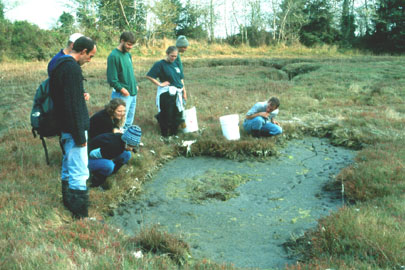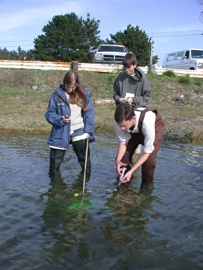ESTUARINE BIOLOGY
(BI 454/554, 5 credits)
This course will be taught in Fall 2012 @
OIMB by R. Emlet.
See
also: http://darkwing.uoregon.edu/~oimb/academics.html
ESTUARINE
BIOLOGY (BI 454/554, 5 credits) --- class meets all day, one day each
week, and for an additional hour on Friday
Week
1 Intro. to estuaries, tides and
benthic organisms
Week 2 Physical
properties of an estuary (circulation and sedimentation)
Week 3 Salt Marshes started
Week 4 Salt Marshes continued & Mangrove
comparisons
Week 5 Seagrasses,
phytoplankton, and detritus
Week 6 Benthic communities
Week 7 more on Benthic infaunal Communities
Week 8 Estuarine Sediments and Anoxia
Week 9 Fouling Communities
Week 10 Wrap up
and overviews
Final Exam is Tuesday Dec 7 of exam week
ACTUAL and detailed
SCHEDULE from Fall 2011
PLEASE NOTE: This is subject to change on 2012, but it will give you
an idea of what the course will include.
ESTUARINE BIOLOGY
(BI 454/554, 5 credits)
Class
Schedule: Tuesday, 8:30* - 17:00 and Fridays, 11:00-12:00 *See
exceptions below
Week 1 Introduction to estuaries, tides and
benthic organisms
Sept 27 06:21 +0.36 ft hLow
*07:20 Field trip to Portside mudflat - collect infaunal
organisms
09:45 Lecture:
Introduction to the class, goals.
10:15 Lecture:
Overview of estuaries – importance, distribution in space and time.
11:15 Sieve
mud and set up aquaria of sediment
13:15 Finish sieving and settling up aquaria
with organisms
14:15 Field trip to floating docks to see fouling communities/introduced species/water
movement
16:00 Discuss,
plan, set-up, and deploy fouling plate study…
Sept 30 11:00 Discussion
Week 2 Benthic organisms and physical properties of an estuary
October 4
07:21 +5.85 ft lHigh
(sunrise: 07:18) 12:36 +3.35 ft hLow
08:30 Lecture: Types of estuaries and circulation
10:00 Field trip: Boat trip up Coos Estuary –
sampling stations for temp salinity, sediments
Group 1 depart at 10:00 am
Group 2 meet at x and arrive at
exchange site at x
16:00 Lecture: Tides
Oct 7 11:00 Discussion
Week 3
Oct 11 06:15 +1.80 ft hLow 12:21 +7.7 ft hHigh; 18:50 +0.47 ft lLow
08:30 Lecture: Estuarine sedimentation AND gradients, +/-
oxygen, other physical characteristics
10:00 Start work up data from cruise (homework
- make graphs from CB transect)
Sometime today: talk about the CB
CTD transect and Secchi data
Oct
14 11:00 Discussion
Week 4 Saltmarshes
Oct 18 10:19 +3.81 ft hLow 16:13 +6.91 ft hHigh
08:30 Lecture: Saltmarshes
10:00 Fieldtrip
to Metcalf Marsh, plant identification, quantitative transects
13:15 Begin
laboratory to work up field samples
16:00 Lecture:
Mangroves - replacement of salt-marsh in the tropics
Oct
21 11:00 Discussion
Week 5 The estuarine environment and boundary layers
Oct 25 11:15 +8:58 ft hHigh 17:53 -0.76 ft lLow
08:30 Estuarine Organism Quiz (on fouling and mudflat
organisms)
09:30 Lecture on boundary layers
11:00 Laboratory: Process samples salt marsh
samples.
13:15 Field trip to measure boundary
layers
15:30 Work up boundary layer data
Oct 28 11:00 Discussion
Week 6 Benthic
Communities
Nov 1 11:06 +3.34 ft hLow 16:53 +7.12 ft hHigh08:30 Midterm Exam I
10:30 Lecture: Larval biology in estuaries.
11:30 Laboratory - weigh sediment and plant samples
13:15 Lecture: Estuarine animals & infaunal community interactions I.
14:30 Bring in settlement plates and evaluate 6
week outcome.
Nov
4 11:00 Discussion
(DAYLIGHT
SAVINGS TIME ENDS THIS WEEK END)
Week 7 More
on Benthic Communities
Nov 8 16:54 +0.37 ft lLow (sunset 17:00)
8:30 Lecture: Infaunal
community interactions
II.
10:00 Lecture: Infaunal
community interactions
III.
15:15 Field trip to Dome House sand flat for
quantitative sampling of infauna.
Nov 11 11:00 Discussion
Week 8 Seagrasses,
Phytoplankton and Detritus Estuarine
Nov 15 08:18 +3.78 ft hLow 14:02 +7.46 ft hHigh
08:30 Lecture: Seagrass communities, importance &
ecology
10:00 Lecture: Estuaries: Planktonic
communities and patterns
1100 Possibly work on sediment samples
13:15 Lecture: Lecture: Estuarine production,
detritus and energy flows
14:30 Lab: Re-weigh saltmarsh
plants and sediments.
15:30 Field trip to SSNERR or plankton sampling?
Nov
18 11:00 Discussion
Week 9 Sediments and
Anoxia
Nov 22 08:55 +8.5 ft hHigh 15:50 -0.48 ft lLow (sunset 16:47)
08:30 Lecture:
Decomposition, sediment chemistry and biogeochemical cycling
10:00 Field
trip trawling on "RV PLUTEUS" to collect subtidal
organisms of the Coos estuary
13:15 Convene in lab, look at and key out organisms collected on morning dredge trip. Nov 25 No discussion (Thanksgiving)
Week 10 Fouling
Communities and Negative Estuaries
Nov 29 08:46 +3.15 hLow
08:30
Lecture: Fouling communities and
Introduced Species
10:00
Collect fouling plate experiment and evaluate
13:00 Lecture: Negative estuaries and other
topics TBA
15:00 Lab clean up.
Dec
2 11:00 Discussion
Dec 8 Final Exam is Tuesday
of exam week: 8:30 to 10:30 am in classroom.
Estuarine Biology 2011, Fall Quarter OIMB
LIST OF PAPERS FOR WEEKLY DISCUSSIONS: We meet on Friday’s @ 11:00
Wk 1(Sept 30)
1) Lotze, H. K., H. S. Lenihan, et
al. (2006) Depletion, degradation, and recovery potential of estuaries and
coastal seas. Science 312:
1806-1809. (pdf)
2)
Elliott, M. and A. K. Whitfield (2011) Challenging paradigms in estuarine
ecology and management. Estuarine,
Coastal
and Shelf Science 94: 306-314. (pdf)
Wk 2 (Oct 7):
1) Roegner, G.C. and A.L. Shanks (2001) Import of coastally
derived chlorophyll a to South Slough Oregon. Estuaries 24: 244-256. (pdf)
2)
Rand, P. S., S. G. Hinch,
et al. (2006) Effects of river discharge, temperature, and future climates on energetics and mortality
of adult
migrating Fraser River sockeye salmon." Trans. Amer. Fish. Soc. 135: 655-667. (pdf)
Wk 3 (Oct 14):
1) Miller, B. A.
and S. Sadro (2003) Residence time and seasonal
movements of juvenile coho salmon in the ecotone and lower estuary of Winchester Creek, South
Slough, Oregon. Trans. Amer. Fish. Soc. 132: 546-559. (pdf)
2) Hering, D.K., D.L. Bottom, E.F. Prentice, K.K. Jones, and
I.A. Fleming (2010) Tidal movements and residency of subyearling
Chinook salmon (Oncorhynchus tshawytscha)
in an Oregon salt marsh channel. Can. J. Fish. Aquatic. Sci. 67:524-533
(pdf)
Wk 4 (Oct 21):
1) Hacker, S. D.
and M. D. Bertness (1999) Experimental evidence for
factors maintaining plant species diversity in a New England salt marsh. Ecology 80: 2064-2073. (pdf)
2) Sala, N. M., M. D. Bertness, et al. (2008) The
dynamics of bottom-up and top-down control in a New England salt marsh.
Oikos 117: 1050-1056. (pdf)
Wk 5 (Oct 28):
1) Woodin, S.A., D.S. Wethey, and N.
Volkenborn (2010) Infaunal
hydraulic ecosystem engineers: cast of characters and impacts. Integr. Comp. Biol. 50: 176-187. (pdf)
Wk 6 (Nov 4):
1) Micheli, F. (1997) Effects of predator foraging behavior on
patterns of prey mortality in soft bottoms. Ecological Monographs 67:
203-224. (pdf)
Wk 7 (Nov 11):
1) Lenihan, H. S., C. H. Peterson, et al. (2001) Cascading of
habitat degradation: oyster reefs invaded by refugee fishes escaping stress. Ecological
Applications 11: 764-782. (pdf)
2)
Seitz, R.D., D.M. Dauer, R.J. Llansó
and W.C. Long. (2009) Broad-scale effects of hypoxia on benthic community
structure
in Chesapeake Bay, USA. Journal
of Experimental Marine Biology and Ecology 381, Supplement: S4-S12. (pdf)
Wk 8 (Nov 18):
1) Marguillier, S. et al. (1997) Trophic
relationships in an interlinked mangrove-seagrass
ecosystem as traced by
∆13C and
∆15N. Mar.
Ecol. Prog. Ser. 151: 115-121. (pdf)
2) Howe, E. and
C. Simenstad (2011) Isotopic determination of food web
origins in restoring and ancient estuarine wetlands of the San Francisco Bay
and Delta. Estuaries and Coasts 34:
597-617. (pdf)
Wk 9 (Nov 25) Thanksgiving break - No class
Wk10 (Dec 2):
1) Beck, N.G.
and K.W. Bruland. (2000) Diel biogeochemical cycling in a hyperventilating shallow
estuarine environment. Estuaries
23: 177-187. (pdf)
2) Paerl, H. W., L. M. Valdes, et al. (2006) Anthropogenic and
climatic influences on the eutrophication of large
estuarine ecosystems. Limnology and Oceanography 51(1): 448-462. (pdf)





